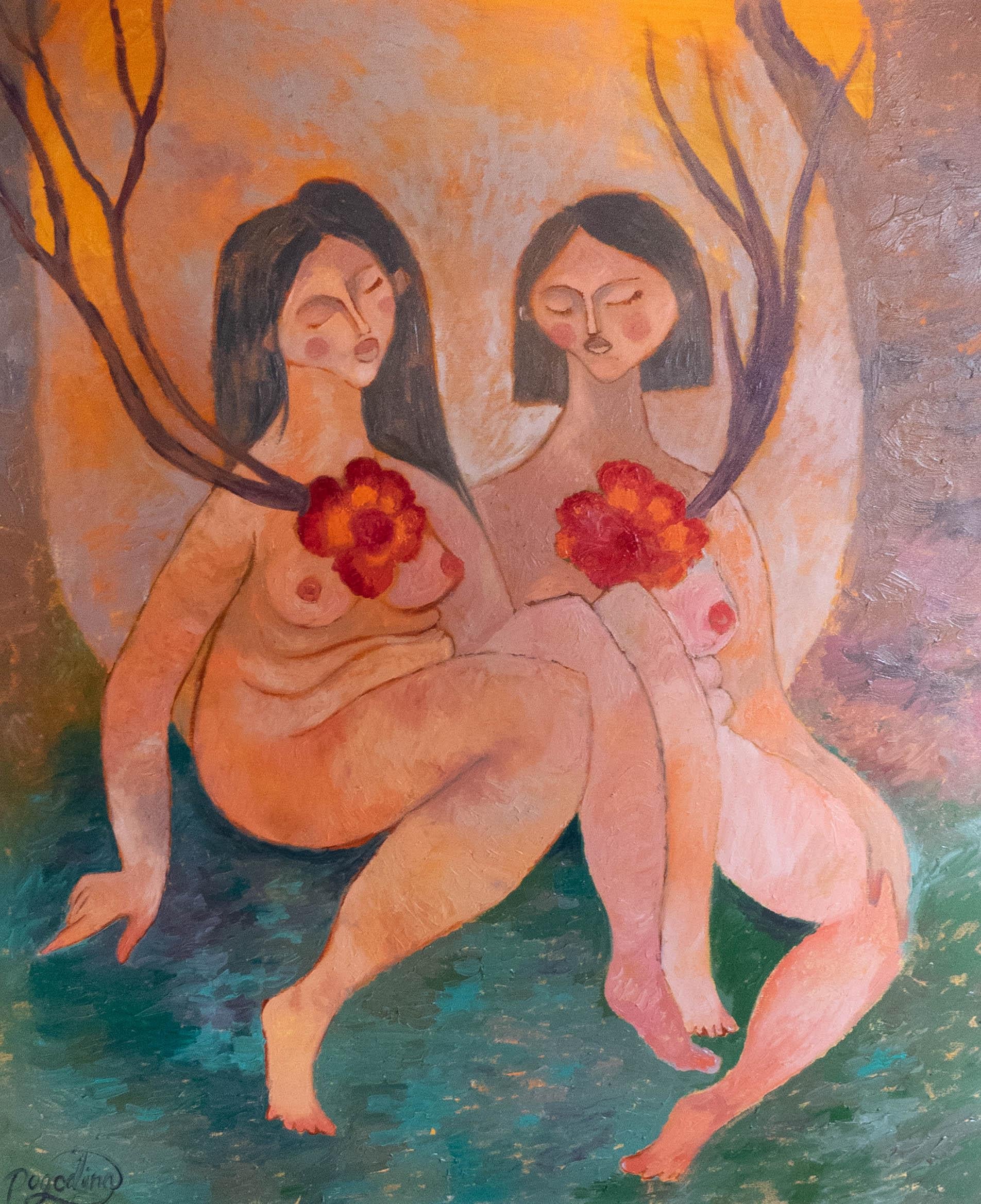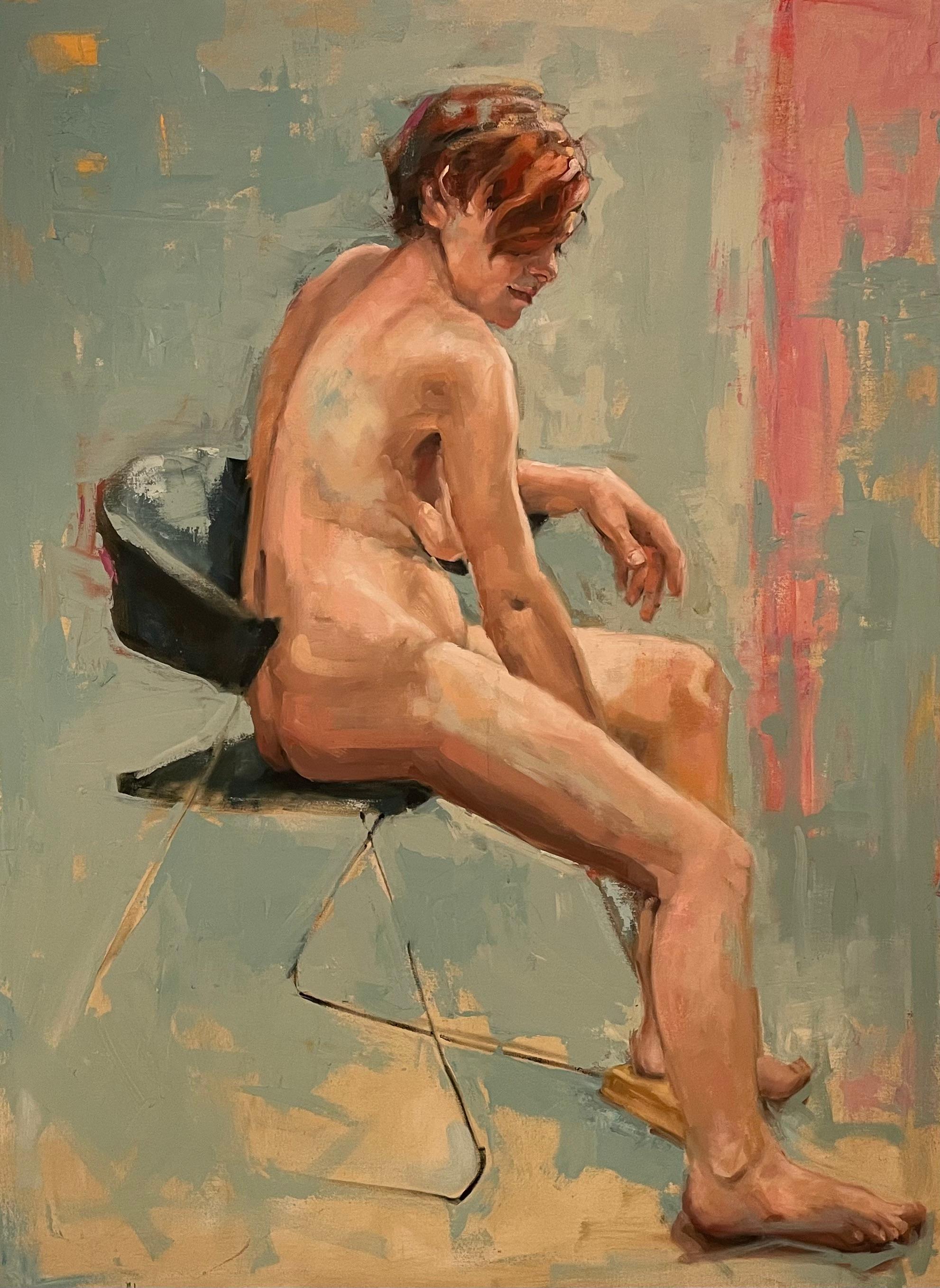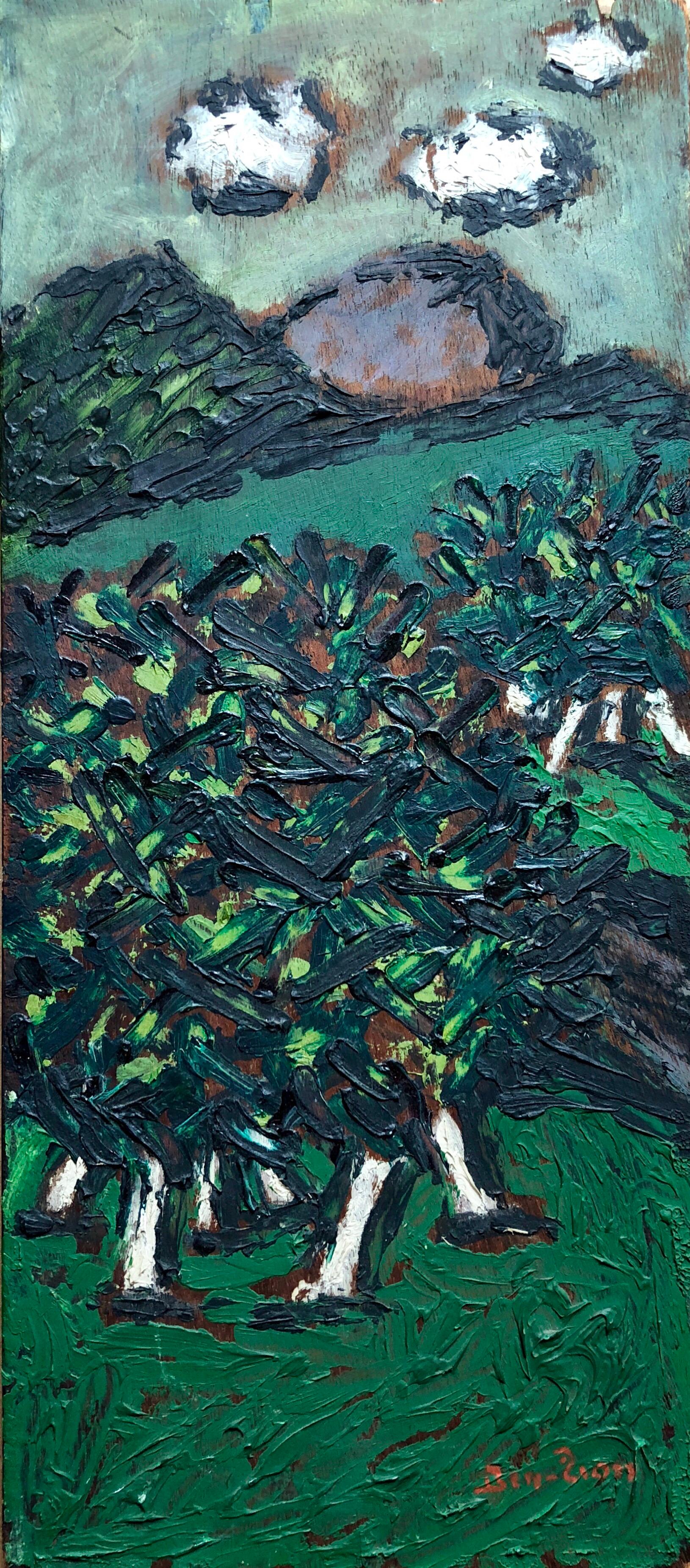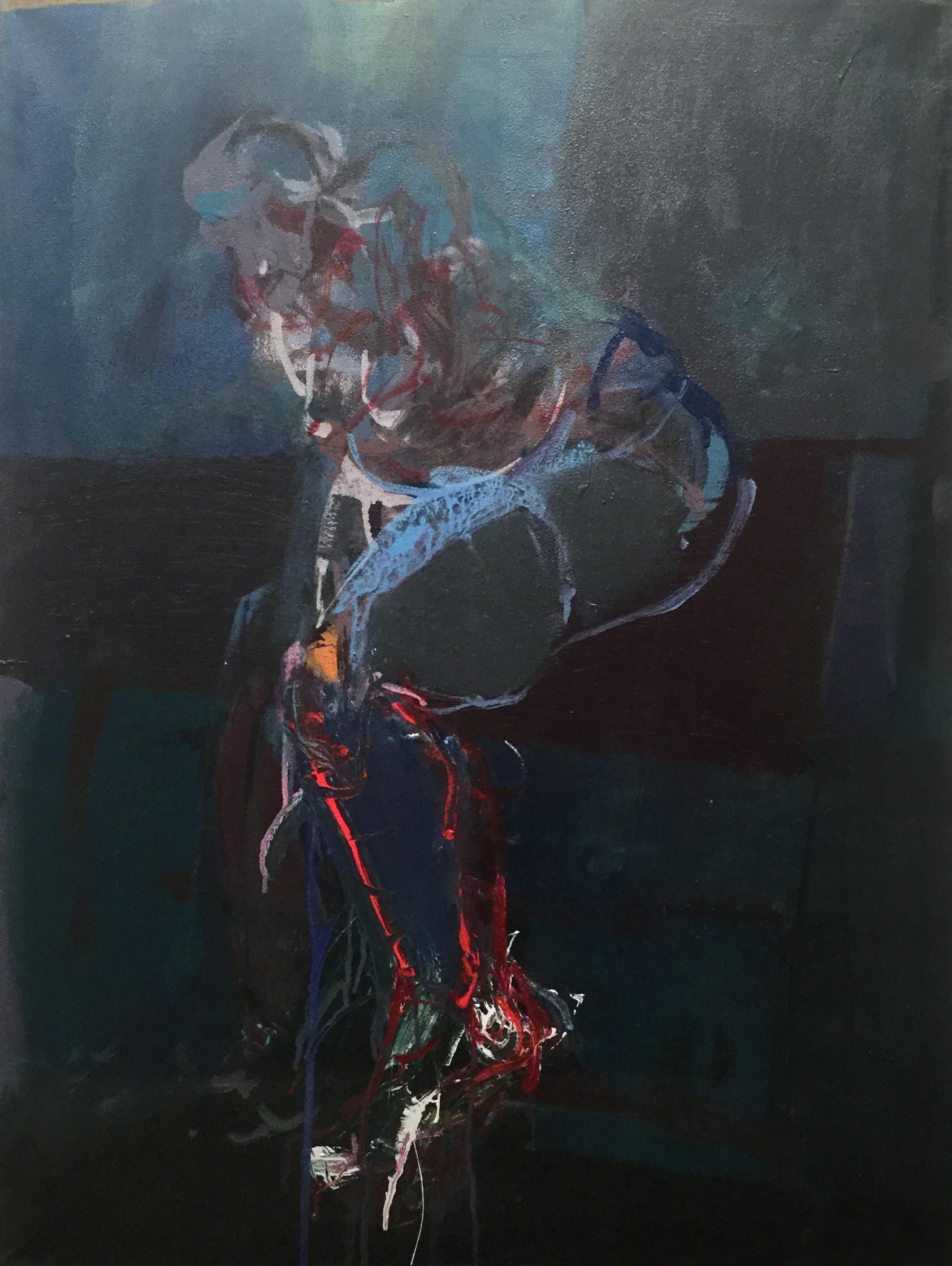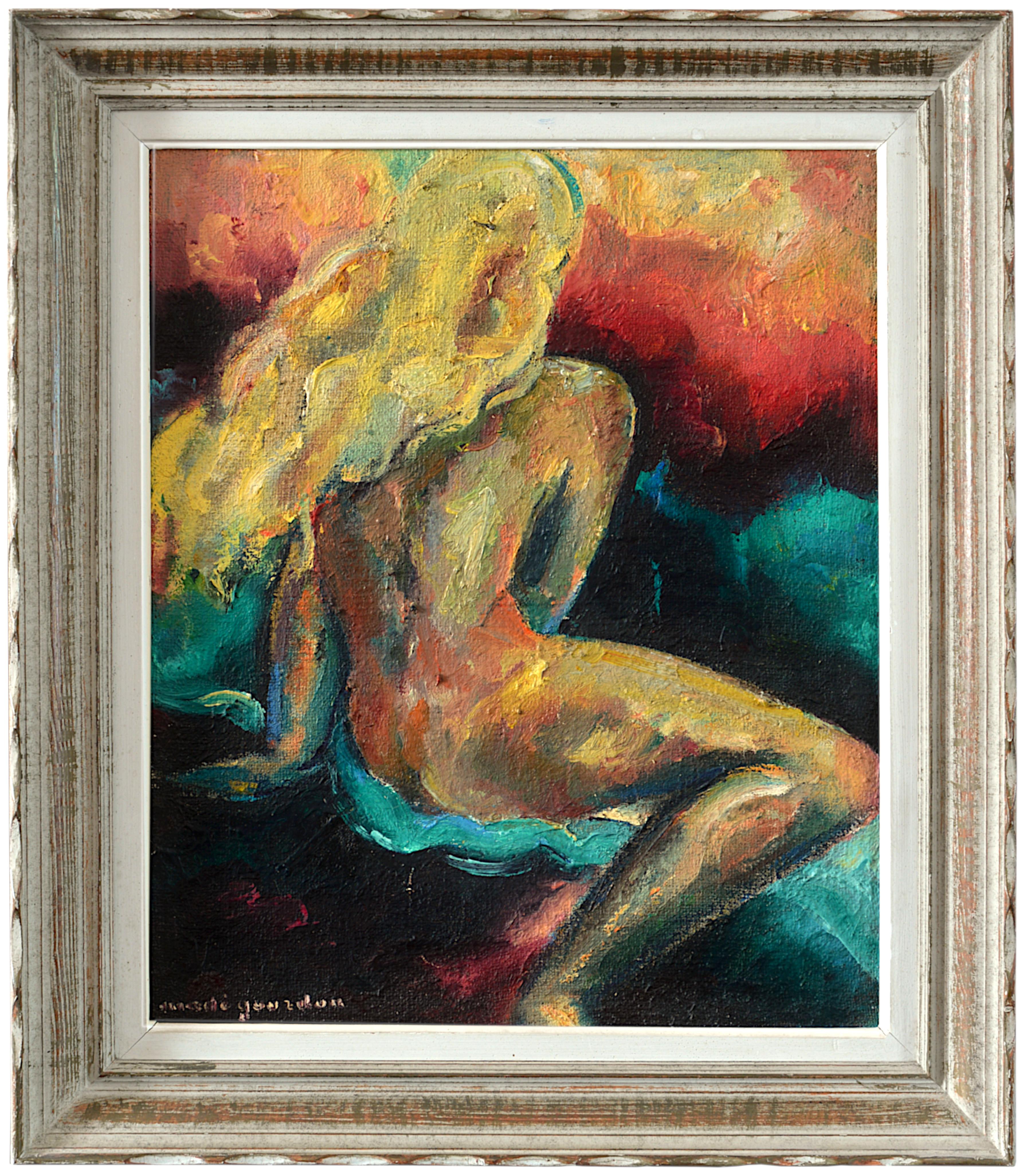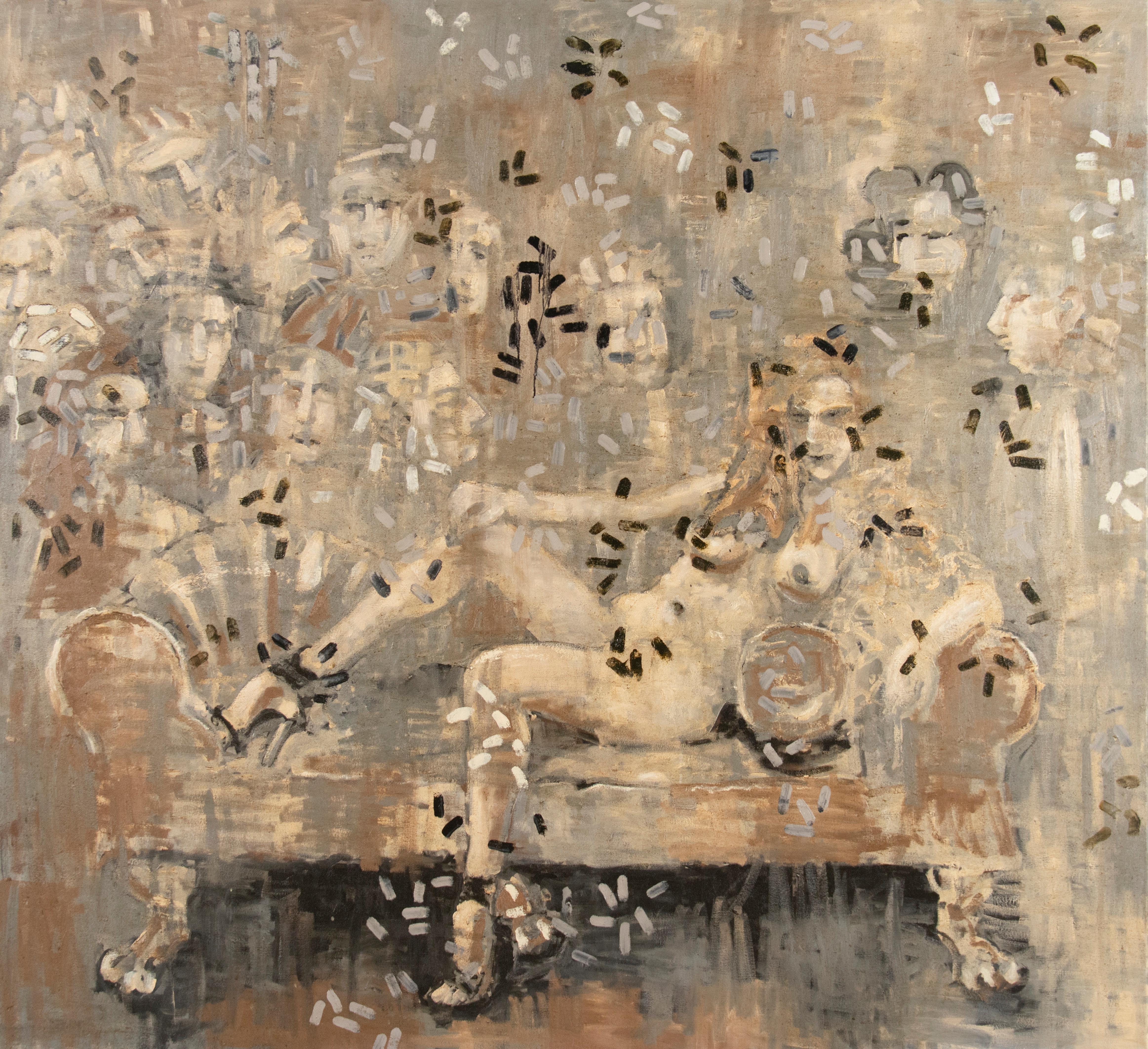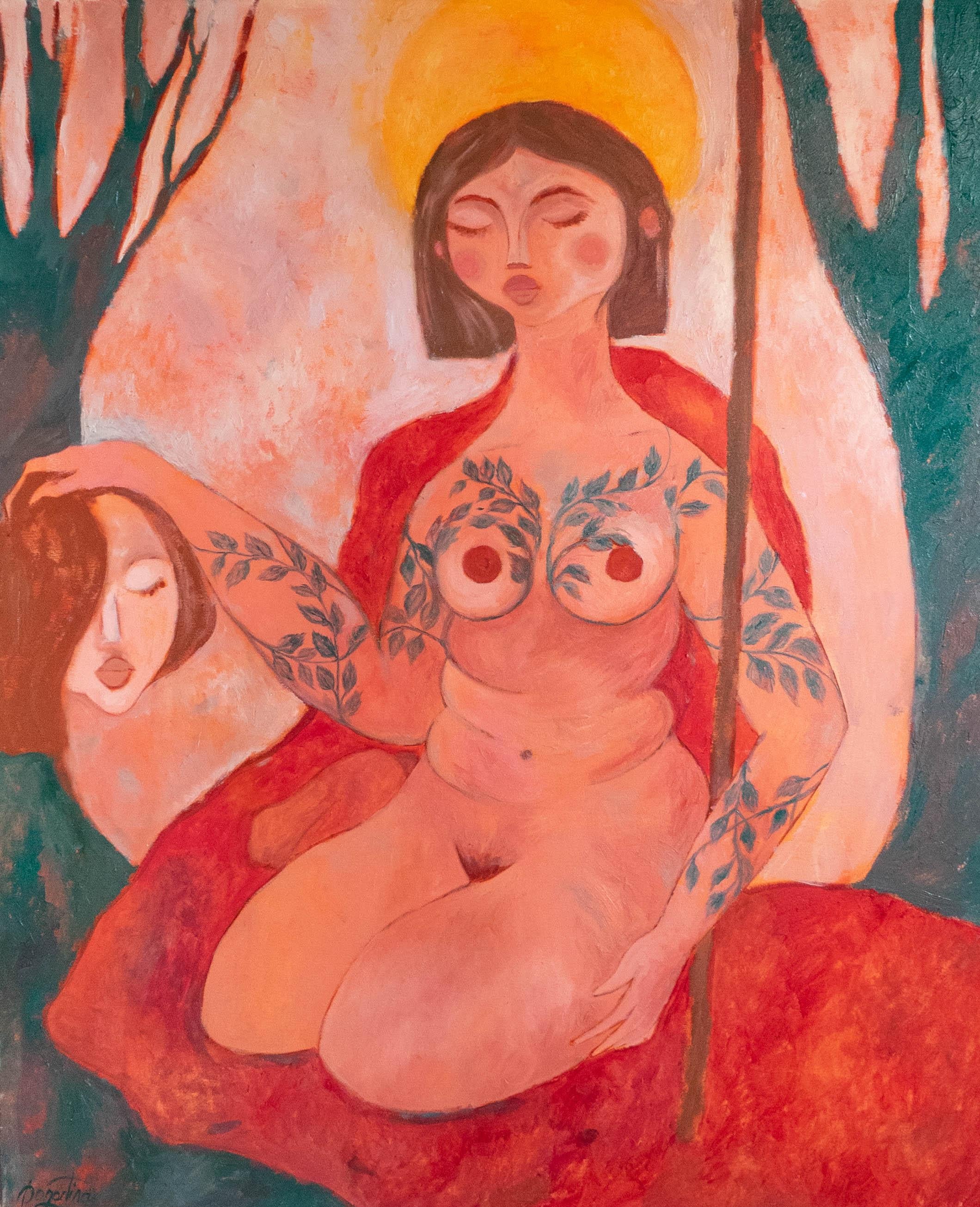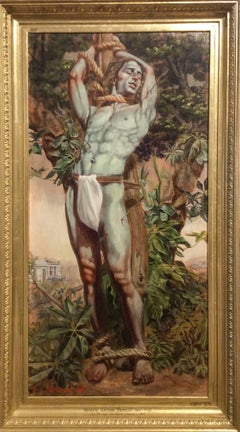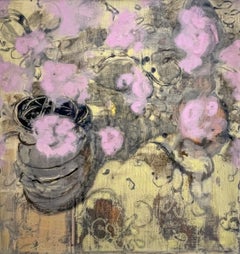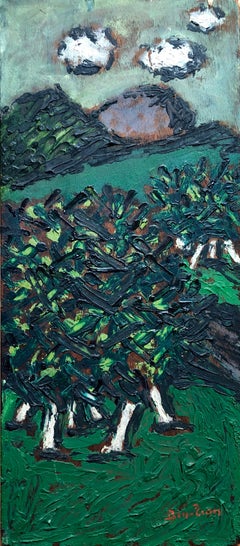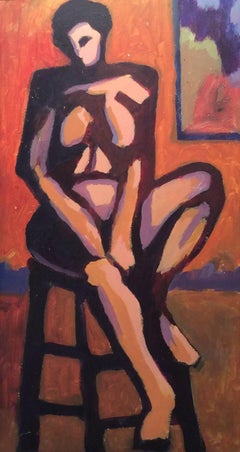
Seated Nude (Abstracted Figurative Female Nude Painting on Panel, Black Frame)
View Similar Items
Want more images or videos?
Request additional images or videos from the seller
1 of 8
Stephen BrophySeated Nude (Abstracted Figurative Female Nude Painting on Panel, Black Frame)1975
1975
About the Item
- Creator:
- Creation Year:1975
- Dimensions:Height: 25 in (63.5 cm)Width: 16 in (40.64 cm)
- Medium:
- Movement & Style:
- Period:
- Condition:
- Gallery Location:Hudson, NY
- Reference Number:1stDibs: LU2271294693
About the Seller
5.0
Platinum Seller
These expertly vetted sellers are 1stDibs' most experienced sellers and are rated highest by our customers.
Established in 1991
1stDibs seller since 2013
544 sales on 1stDibs
Typical response time: 2 hours
More From This SellerView All
- Le Martyr de Saint Sebastian (Academic Figurative Oil Painting in Gold Frame)By Mark BeardLocated in Hudson, NYAcademic style figurative oil painting on canvas 48 x 24 inches unframed 58 x 32 x 3 inches in gold leaf wood frame This vertical, contemporary figurative painting of Le Martyr de Saint Sebastian was made by Mark Beard under his fictitious artistic persona, Hippolyte-Alexandre Michallon. Painted in a modern Academic style, Beard paints this Christian saint with dramatic detail and emotional gravity. The scene is a common artistic depiction of Sebastian who according to traditional belief, was killed during the Roman emperor Diocletian's persecution of the Christians. Here the artist depicts a nearly nude Saint Sebastian standing stoically while tied to a rustic brown post. A lush green forested terrain decorates the background while a white neo-classical building sits in the distance, which is perhaps the tomb where Saint Sebastian's remains were laid to rest. Saint Sebastian's pale blue-grey, stone-like stone tone is characteristic of Mark Beard's work who often portrays muscular young men similarly to Greek statues. The vertical Academic style figurative oil painting is complimented with a vintage style gold leaf wood frame. The painting is signed 'H. A. Michallon 1872' in red oil paint in the lower right corner. The gold frame is also signed and inscribed with black oil paint in several places (please see images). Mark Beard is a contemporary artist who made this work under the pseudonym Hippolyte A. Michallon who painted during the late 1800's so slight wear (see images) is intentionally staged to align with the factitious artist's purposed history. About the artist: Mark Beard is perhaps the most literal example of an artist pulled in so many different directions that he chose to “invent” six different personae in which to channel his overflowing energy and need for expression. Each painting style is radically different from the next, so it remains entirely believable that the work could stem from six completely different people of different time periods and different schools of thought. With a background in set design, Beard has always been one who could conjure total magic with anything available. Mark Beard has exhibited with Carrie Haddad Gallery for nearly twenty years and there has never been a dull moment. Mark Beard, born in 1956 in Salt Lake city, now lives in New York City. His works are in museum collections worldwide, including the Metropolitan Museum of Art, New York City; the Museum of Modern Art, New York City; the Whitney Museum of American Art, New York City; the Boston Museum of Fine Arts; and the Harvard, Yale, and Princeton University Art Museums; among many others. We would not be the least bit surprised to see new ‘personas’ emerge in the coming years. About: Hippolyte - Alexandre Michallon, 1849 -1930 The long and peripatetic artistic career of Hippolyte-Alexandre Michallon began in a conventional fashion. The only son of prosperous bourgeois parents in Tours, he first studied drawing with his mother, an accomplished amateur painter of insects. His father, an undertaker who appreciated his son's talent and supported his ambition to become a painter, sent him to Paris at age sixteen to enroll in the studio of Francois-Edouard Picot (1786-1868), an eminent history painter and professor at the Ecole des Beaux-Arts, with whom he studied for three years, until Picot's death. Under his aging teacher's guidance and tutelage, Michallon entered the preliminary stages of the Prix de Rome contest at the Ecole three times, winning an Honorable Mention in 1869 for his composition entitled The Solider of the Marathon. For the next twenty years Michallon regualarly exhibited paintings on historical and biblical themes at the Paris Salon, as well as commissioned portraits. By his own account, the most ambitious work of Michallon's career was a thirty-foot canvas depicting Noah's Ark, which he exhibited in the Salon in 1875. Michallon began painting atmospheric but zoologically correct images of exotic animals in the wild. These achieved a certain popularity among French and foreign collectors alike, providing Michallon with financial security for the first time in his career. Michallon moved to England in 1893. His outstanding technical skills easily earned him a position on the faculty of the Slade School of Art in 1900. The craze for animal paintings proved short-lived. He continued to teach at Slade for the next two decades, but his classes gradually dwindled in size as the academic approach and methods he espoused went from outmoded to downright unpopular. Finally in 1922, finding himself reduced to a single pupil, the talented young American Bruce Sargeant, he retired from Slade, persuading Sargeant to leave with him and undergo private instruction at home. Several years later he retired to a cottage at St. Ives, Cornwall, where he lived quietly until his death in 1930, forgotten by all but a few former students, among them Edith Thayer Cromwell...Category
Early 2000s Academic Figurative Paintings
MaterialsCanvas, Oil
- Weightless, Timeless: Oil Painting of Two Women Swimming in PoolBy Samantha FrenchLocated in Hudson, NYHorizontal figurative photo-realist painting of women swimming in an aqua blue pool "Weightless, Timeless," painted by Hudson Valley artist, Samantha French, is 2019 oil on canvas, 48 x 60 inches Sides are cleanly painted white so additional framing is optional Excellent condition and ready to hang as is This photorealist figurative painting captures a peaceful water scene of a women leisurely floating in a crisp, aqua blue pool. The sunlight reflecting off their sun kissed skin complements the cool color palette, making for a serene visual experience. The brush work is highly detailed with little texture (impasto) on the surface. The horizontal painting on canvas is currently unframed and has clean, white painted sides, so additional framing is optional. About the Artist: Born and raised in north central Minnesota, Samantha French graduated from the Minneapolis College of Art and Design in 2005. French’s current body of work explores the idea of escape, the tranquility and nostalgia for the lazy summer days of her childhood. The series is inspired by Samantha’s own reflections and memories of her childhood summers spent in the lakes of Northern Minnesota. French actively exhibits her paintings and is included in many private and public collections throughout the country while her work has garnered extensive international and national press. She is a full-time painter and keeps a studio in New York’s Hudson Valley. "My current body of work is focused on swimmers underwater and above. Using vague yet consuming memories from my childhood summers spent immersed in the tepid lakes of northern Minnesota, I attempt to recreate the quiet tranquility of water and nature; of days spent sinking and floating, still and peaceful. These paintings are a link to my home and continual search for the feeling of the sun on my face and warm summer days at the lake. They are my escape, a subtle reprieve from the day-to-day. At the same time, I am drawn to an idealistic time before my own, where swim caps and wool swimsuits were commonplace. This combination of memory, observation and photography has allowed me to preserve the transitory qualities of water and remembrance." Artist Resume: 2019 Winter Swim, Rubine Red...Category
2010s Photorealist Figurative Paintings
MaterialsCanvas, Oil
- Vase of Pinks (Abstract Still Life Painting of Light Purple and Pink Flowers)By David KonigsbergLocated in Hudson, NY"Vase of Pinks" exemplifies all the hallmarks of a David Konigsberg painting: abstract liberties within representation, a rapturous handling of color, and an aesthetic that seamlessl...Category
2010s Contemporary Still-life Paintings
MaterialsPanel, Oil
- Burning Fog Over NYC: Abstract Color Field Landscape Painting of New York CityBy Ricardo MuleroLocated in Hudson, NYAbstract color-field landscape painting of the New York City skyline against an ethereal soft blue and red hazy sky "Burning Fog Over NYC" by Hudson, NY based artist, Ricardo Mulero,...Category
2010s Color-Field Landscape Paintings
MaterialsGesso, Muslin, Oil, Panel, Wood Panel
- From Olana (Expressive, Plein Air Landscape Painting, Home of Frederic Church)By John KellyLocated in Hudson, NYGestural, en plein air winter landscape painting of "Olana", the historic home of Hudson River School painter, Frederic Edwin Church Painted in the winter of 2023, by Hudson Valley b...Category
2010s Contemporary Landscape Paintings
MaterialsOil, Wood Panel
- Madison Street (Realistic Oil Painting of New York City Building Edifice)By Richard BritellLocated in Hudson, NYRealistic, richly colorful oil painting of New York City edifice by Richard Britell oil on wood panel 10 x 8 inches Framed, hangs flush ...Category
2010s Contemporary Figurative Paintings
MaterialsWood Panel, Oil
You May Also Like
- "Young Woman Seated" Green & Pink Contemporary Figurative Nude by Shana WilsonBy Shana WilsonLocated in Carmel, CAIn "Nude Woman Seated," a 40" x 30" oil on wood panel by Shana Wilson, there is an intimate portrayal of vulnerability and quiet strength. The artist employs a soft, earth-toned palette, with shades of warm beige, muted greens, and accents of coral, to craft the figure’s delicate form. Wilson's loose, confident brushstrokes lend a raw, textured quality, while the interplay of light and shadow captures the natural curves of the human body. The solitary figure, caught in a moment of repose, exudes a contemplative air, inviting viewers to reflect on the complexities of the human form and the subtle narratives contained within stillness. About the Artist: Over seven billion souls exist on this planet, each with a unique face and story. Shana transfers her visceral love for the human landscape to canvas, tenderly cradling its peaks and valleys, darkness and light, colors and neutrals, empty and full, hard edges and soft curves. Each brush stroke creates a controlled cacophony as it assembles the intricate jigsaw of the human face. An entire life’s journey is written on this human landscape; a journey that begs to be documented and treasured. Shana’s legacy project is to paint inspirational women from all walks of life, inclusive of all cultures and orientations. The subjects all have one thing in common; the ability to inspire and create social change. She pays tribute to them on canvas, painting a long overdue celebration of trail-blazing women. Visit any major gallery or museum in the world and it is teeming with paintings of nude women...Category
21st Century and Contemporary Expressionist Figurative Paintings
MaterialsWood Panel, Oil
$7,500 Sale Price25% Off - American Modernist Oil Painting Gestural Landscape WPA Artist Group of 10By Ben-Zion WeinmanLocated in Surfside, FLBorn in 1897, Ben-Zion Weinman celebrated his European Jewish heritage in his visual works as a sculptor, painter, and printmaker. Influenced by Spinoza, Knut Hamsun, and Wladyslaw Reymont, as well as Hebrew literature, Ben-Zion wrote poetry and essays that, like his visual work, attempt to reveal the deep “connection between man and the divine, and between man and earth.” An emigrant from the Ukraine, he came to the US in 1920. He wrote fairy tales and poems in Hebrew under the name Benzion Weinman, but when he began painting he dropped his last name and hyphenated his first, saying an artist needed only one name. Ben-Zion was a founding member of “The Ten: An Independent Group” The Ten” a 1930’s avant-garde group, Painted on anything handy. Ben-Zion often used cabinet doors...Category
Mid-20th Century Expressionist Figurative Paintings
MaterialsOil, Wood Panel
- Seated NudeBy Helge HelmeLocated in New York, NYAxel Henry Helge Helme (1894 Roskilde, Denmark 1987), Seated Nude, circa 1930, oil on canvas, original frame Son of a merchant, Helge Helme was admitted ...Category
20th Century Expressionist Nude Paintings
MaterialsOil, Canvas
Price Upon Request - "Aquarius" Oil Painting 31.5" x 51" inch by Sergey DolmatovLocated in Culver City, CA"Aquarius" Oil Painting 31.5" x 51" inch by Sergey Dolmatov Year: 2014Category
21st Century and Contemporary Expressionist Figurative Paintings
MaterialsCanvas, Oil
- Female Nude Sitting Figure - Expressive Oil PaintingBy Agata Czeremuszkin-ChrutLocated in Salzburg, ATAgata Czeremuszkin-Chrut was born in 1983 in Czestochowa, Poland. She graduated from the Academy of the Fine Arts in Wroclaw (2008) with the Master degree in Painting. In 2007 she st...Category
2010s Expressionist Nude Paintings
MaterialsOil, Canvas
- Nandor Vagh Weinmann, Oil on cardboard, Naked Back, 1930sLocated in Saint Amans des cots, FROil on cardboard by Nandor VAGH WEINMANN (1897-1978), France, 1930s. Naked back. With frame: 64x56 cm - 25.2x22 inches ; without frame: 46x38cm - 18.1x15 inches. 8F format. Signed "Nandor V. Weinmann" lower left. In its Montparnasse frame. Very good condition. Born October 3, 1897 in Budapest, Nándor is the older brother of Elemer and Maurice Vagh-Weinmann. He came to Paris to present his work in 1931. He died on December 12, 1978 near Montereau (Seine-et-Marne) following an automobile accident. He is the most colorful of the three “expressionist” brothers. Painter of figures, landscapes, especially open mountains, and bouquets in bright colors. He is also a religious painter and then finds the tragic condition. Born in BUDAPEST on October 3, 1897, Nandor Vagh Weinmann belongs to a profoundly artistic people. Living in the heart of Central Europe where they came from Asia a millennium ago, the Hungarians have preserved a strong ethnic individuality whose mark is their very synthetic, non-Indo-European language. Resistant to secular invasions, they have kept the virtues of a very ancient humanity that have become rare in our modern world, especially since their way of life has remained essentially rural until today. In the arts they know how to express a generous, extreme sensibility and by the poetic verb, by the musical rhythms and also by a popular art of a richness, an exceptional harmony. Until the age of thirty-four, during the decisive years of childhood and youth, Nandor Vagh Weinmann was intimately imbued with popular life and the soul of Hungary. From the capital where his father was a jeweler and had a family of ten children, Nandor was the fifth, he knew first of all the suburbs, the populated districts, the rigors in winter of the cold and the snow. A very mobile existence made him acquainted with all of Hungary, from the Danube to Transylvania, its infinite plains and its wild mountains, its immense villages with ample low houses, and its towns which are still immense villages. The painter is passionate about rustic works, harvest scenes, beautiful folk costumes. Coming into direct contact with the peasants, he learned to know their soul. These contacts gave the artist a direct feeling for popular life and soul, as Millet once understood the peasants of Barbizon and Normandy whose existence he shared. What fascinated Nandor Vagh Weinmann above all were the festivals which enlivened the dreary life of the countryside, the circuses, the merry-go-rounds, the gypsies unleashing orgies of music, light and color. In the party, and especially the Hungarian party, the whole soul of a people, all its energy, its need for movement, for intensity, is expressed in its pure state and realizes the primary and essential form of what is called beauty. And as if melted at the party, there is the infinite steppe where herds of horses and oxen circulate where terrible storms sometimes roar where the seasons unfold their grandiose splendours. The young Nandor Vagh Weinmann nourishes his sensitivity to his inexhaustible shows, both eternal and always new, a sensitivity which very early declared itself that of a painter. Since the age of fourteen he painted, and since then he never stopped doing it. Two of his brothers Maurice, two years his junior, who had a remarkable career similar to that of Nandor and later Elemer who became Maurice's pupil, also devoted themselves to painting, despite family obstacles. And the three brothers united by a common passion worked together in Hungary and later in France. Painting was so much in the blood of the family, as in the past among the Veroneses, the Breughels, the Lenains, the Van Loos and so many other artistic dynasties, that three sons of the Vagh Weinmanns became painters in their turn. One of these, Emeric, son of Nandor, today occupies an important place in the contemporary school. Nandor, at fifteen, was a pupil of the Academy of Fine Arts in Budapest where he worked diligently, then at that of Vienna. He painted many portraits, but also landscapes, compositions and, by his relentless work, managed to live from his brush, although married very young and having to overcome many hardships. He therefore knew the hardships and miseries of life. These strongly impregnated his vision as an artist and explain the thrill of humanity that runs through all his work. A particularly moving experience was reserved for him at the age of twenty. In the hospitals of Budapest he had to paint extraordinary cases, operations, frightful wounds, the deformations to which our poor body is subjected by traumas and physiological decompositions. In these circumstances, it is not a question of gratuitous art, of formal research but of immediate, authentic expressions of our flesh and our being. We know that Breughel Velázquez and Goya had been haunted by the sight of cripples and of madmen Géricault by that of corpses. But life is ultimately stronger than anything, and it is life that Nandor Vagh Weinmann has passionately observed and translated through all the places where he has always painted on nature. Nothing stopped him. It happened to him to paint, for example in front of the mill of Linselles by a weather so cold, that nobody could stay outside, and that he did not leave the place before having finished his work. Because he works constantly on the ground, under the sky, in the silence he loves. His reputation is established. He exhibited at the national fair in Budapest, in the big cities of Hungary Szeged, Szombathely, Veszprém, Kaposvar. In 1931, like all artists in the world, he came to France. But unlike the others, he did not settle in Paris. Because Nandor Vagh Weinmann does not belong to this group of cosmopolitans that we call the School of Paris. He settled in Toulouse, where he remained for a long time with his brothers, and traveled throughout France, eager for new ties, exhibiting in the most diverse cities, in Bordeaux, Marseille, Lyon, Agen, Bayonne, Dax, Tarbes, Grenoble, Nice, Cannes, Strasbourg, Mulhouse, Colmar, Lille. He even crossed borders. He was in Saint Sebastian, in Geneva, and once in Egypt in 1927 where he painted King Fouad...Category
1930s Expressionist Figurative Paintings
MaterialsOil, Cardboard
Recently Viewed
View AllMore Ways To Browse
Academic Oil Nude
Nude Texas Artist
Male Nudes Oil Canvas
Antique Nude Oil Paintings
Oil Paintings Antique Nude
Nude Bather Painting
Male Nudes Oil On Canvas
Male Nude Oil Painting On Canvas
Cubist Nude Oil Painting
Vintage Oil Nude
Vintage Nude Oil Painting
Vintage Wrestling Art
Nude Bath
Framed Male Nude Oil
Nude In Bath
Female Nude Cubist
Nude Woman Oil Back
Pink Female Nudes Paintings
